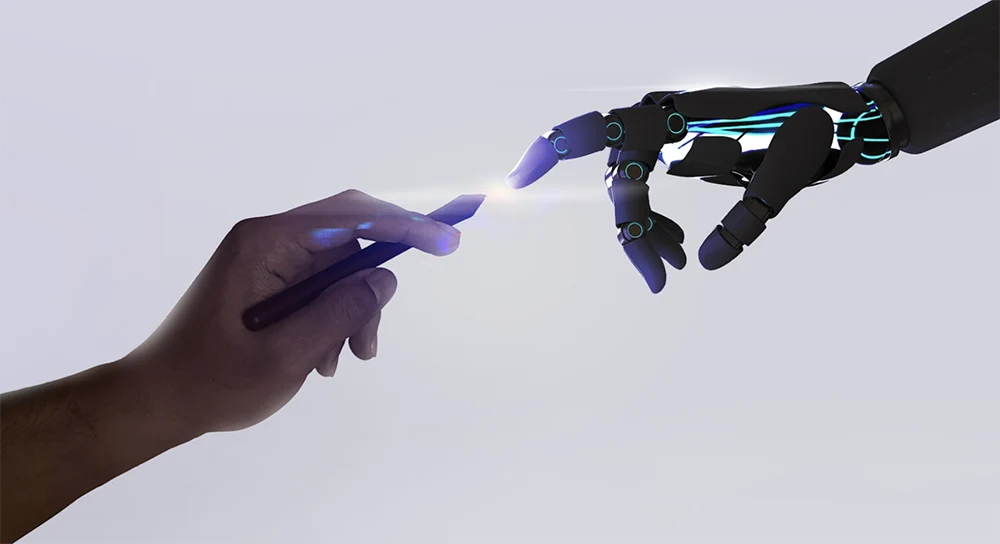Hey Siri…what is AI?
Introducing Students to Artificial Intelligence
Introduction | Background Knowledge | Activities | Extensions | Standards

Introduction
Deep Blue and Alexa and Siri
Artificial intelligence has been a part of our conversations and lives for many years. The world buzzed when Deep Blue beat chess grandmaster Garry Kasparov in 1997. Apple’s Siri has been answering questions since 2011. Amazon’s virtual assistant, Alexa, has been playing music and adding items to our to-do lists since 2014.
Since then, Artificial Intelligence (AI) has been making its way into classrooms nationwide. Teachers can arm themselves with knowledge and use this technology to enhance instruction.

Background Knowledge
The use of Artificial Intelligence (AI) in education is still a relatively new concept. However, the history of AI in education dates back to the 1980s. Here's a brief overview of the history of AI in education:
- Intelligent Tutoring Systems: In the 1980s, AI researchers began developing intelligent tutoring systems to provide personalized guidance to students based on their individual needs and strengths. These systems used machine learning algorithms to adapt to the student's learning style and pace.
- Adaptive Learning: In the 1990s, adaptive learning systems emerged that could adjust the difficulty level of the content based on the student's performance. These systems used AI algorithms to analyze the student's progress and provide personalized feedback.
- Natural Language Processing: In the 2000s, natural language processing (NLP) technologies that could analyze and understand human language were developed. That led to the development of chatbots and virtual assistants that could provide personalized support to students.
- Educational Games and Simulations: In the 2010s, AI-powered educational games and simulations emerged that could provide students with immersive and interactive learning experiences. These games use AI algorithms to adapt to the student’s performance and provide individualized feedback.
- Personalized Learning: Today, AI is used in education to create personalized learning experiences that can adapt to the student's needs, interests, and abilities. This includes using learning analytics and predictive modeling to identify students at risk of falling behind and provide targeted interventions.
Overall, the history of AI in education is an ongoing journey of innovation and experimentation. As AI technology continues to evolve, we can expect to see more advanced and sophisticated AI systems that can help enhance the learning experience for students and teachers alike.
To help my writing process, I used this Grammarly AI prompt:
- "History of AI in education"

ACTIVITIES
-
Selective List of Books
- AI Meets AI: An Exciting Tale of Connection and Adventure by Amber Ivey (ISBN 979-8398261042) - Jaz, an AI robot, gets lost in the city until she meets Addy Iris. Jaz learns about human feelings, while Addy learns how technology works.
- Fuzzy by Tom Angleberger (ISBN 978-1419729683) - Maxine’s school is introducing robotic classmates through the Robot Integration Program. As she and Fuzzy become friends, they take on BARBARA, the digital student evaluation system.
- The Wild Robot by Peter Brown (ISBN 978-0316382007) - Robot Roz comes to life on an island. Surrounded by nature, she learns to survive and befriends the wildlife around her.
- A.I.: How Patterns Helped Artificial Intelligence Defeat World Champion Lee Sedol by Darcy Pattison (ISBN 978-1629441849) - In 2016, AlphaGo, an artificial intelligence computer, played a board game called GO against the best human player in the world.
- ABCs of AI: A Fun and Educational Children's Book: A Beginners Guide to Understanding the World of AI by Robot Rob (ISBN 979-8374645798) - From Artificial Intelligence to Zeta-Calculus, this book introduces students to various aspects of artificial intelligence.
- Artificial Intelligence and Me: The 5 Big Ideas That Every Kid Should Know by Readyai (ISBN 978-1087929798) - Learn about the five big ideas of Artificial Intelligence with Robby and his friends.
-
Start with the basics of Artificial Intelligence:
-
Watch a video -What is AI? Artificial Intelligence Facts for Kids
- Use Twee (TeachersFirst review) to automatically create a set of questions that correspond to the video using AI. Find the Audio & Video Question creator, paste the video URL, choose the type of questions and difficulty level, and then watch the magic happen as a set of questions appears.
-
Review vocabulary associated with Artificial Intelligence.
- Quizizz (TeachersFirst review) automatically creates quizzes from scratch using your vocabulary terms or AI to generate quizzes from any document, link, or prompt. Complete quizzes together as a class, assign them as homework or use the instructor-paced option to share quizzes for students to complete within your chosen time frame.
- Discuss the history of Artificial Intelligence. Begin by using an AI tool such as MyLens (TeachersFirst review) to generate a timeline of Milestones in Artificial Intelligence such as this one.
- Learn to code at Code.org (TeachersFirst review)
- Play with artificial intelligence and help teach the Artificial Intelligence to recognize doodles - QuickDraw (TeachersFirst review) and Scribble Diffusion (TeachersFirst review) provide engaging tools to interact with AI drawing features.
- Teach a computer to recognize text, images, or sounds with Machine Learning for Kids.
- Add color to anime sketches with Petalica Paint.
- Start using ChatGPT with these four activities. ChaptGPT is for students 13 and up. Elementary teachers can modify or model the lessons.
-
Watch a video -What is AI? Artificial Intelligence Facts for Kids
-
Teach students about digital literacy and the ethics of Artificial Intelligence:
- Visit the US Department of Education for ideas on implementation and discussions to have with students.
- View this infographic from Dell Technologies.
- Read this article from Commonsense Media.
- The AI Education Project (TeachersFirst review) shares a free curriculum and learning experiences that teach about AI and using AI responsibly.
-
Integrate real-world examples and technology into lessons:
- Explore a list of real-world AI applications from Forbes magazine.
- Practice research skills by learning more about AI. This lesson incorporates opinion writing as well. You can find resources for research provided by Code.org.
-
Integrate AI into English, math, or music using these ideas.
- Use ChatGPT to answer an essay question. Allow students to use the scoring rubric to score the AI-created response. Finally, write a paragraph or an essay from the opposite perspective.
- Ask AI tools to generate real-world examples for any topic. MagicSchool AI (TeachersFirst review) includes a Real World Connections generator; add your desired grade level and topic, standard, or objective to quickly create a list of real-world applications for your prompt.
- Find a variety of AI tools curated by TeachersFirst.

EXTENSIONS
-
The Way I Feel
- During the morning meeting, read a book about emotions. (The Way I Feel by Janan Cain or Happy Sad Today: Making Sense of Mixed-Together Feelings by Lory Britain are great choices.)
- Pair the text and the discussion with Digital Technologies Hub’s “Can AI Guess Your Emotion?”
-
Simplify Lesson Planning
- Use an AI lesson planner like MagicSchool.ai (TeachersFirst review) or Diffit (TeachersFirst review) to make lesson planning and resource development easier and more efficient.

CORRELATION TO STANDARDS
-
AASL National School Library
Standards
- Inquire Shared Foundation, Think Domain - Learners display curiosity and initiative by: 1. Formulating questions about a personal interest or a curricular topic. 2. Recalling prior and background knowledge as context for new meaning.
- Inquire Shared Foundation: Create Domain: Learners engage with new knowledge by following a process that includes: 1. Using evidence to investigate questions. 2. Devising and implementing a plan to fill knowledge gaps.
- Inquire Shared Foundation, Share Domain - Learners adapt, communicate, and exchange learning products with others in a cycle that includes: 1. Interacting with content presented by others. 2. Providing constructive feedback. 3. Acting on feedback to improve. 4. Sharing products with an authentic audience.
- Include Shared Foundation, Share Domain - Learners exhibit empathy with and tolerance for diverse ideas by: 1. Engaging in informed conversation and active debate. 2. Contributing to discussions in which multiple viewpoints on a topic are expressed.
- Include Shared Foundation, Grow Domain - Learners demonstrate empathy and equity in knowledge building within the global learning community by: 1. Seeking interactions with a range of learners.
- Collaborate Shared Foundation, Think Domain - Learners identify collaborative opportunities by: 1. Demonstrating their desire to broaden and deepen understandings. 2. Developing new understandings through engagement in a learning group. 3. Deciding to solve problems informed by group interaction.
- Collaborate Shared Foundation, Create Domain - s Learners participate in personal, social, and intellectual networks by: 1. Using a variety of communication tools and resources. 2. Establishing connections with other learners to build on their own prior knowledge and create new knowledge.
- Collaborate Shared Foundation, Grow Domain - Learners actively participate with others in learning situations by: 2. Recognizing learning as a social responsibility.
- Explore Shared Foundation, Think Domain - Learners develop and satisfy personal curiosity by: 1. Reading widely and deeply in multiple formats and writing and creating for a variety of purposes.
- Explore Shared Foundation, Create Domain - Learners construct new knowledge by: 1. Problem solving through cycles of design, implementation, and reflection.
- Explore Shared Foundation, Share Domain - Learners engage with the learning community by: 3. Collaboratively identifying innovative solutions to a challenge or problem.
- Explore Shared Foundation, Grow Domain - Learners develop through experience and reflection by: 1. Iteratively responding to challenges. 2. Recognizing capabilities and skills that can be developed, improved, and expanded. 3. Open-mindedly accepting feedback for positive and constructive growth.
-
ISTE Standards for Students
- Empowered Learner - 1b. Students build networks and customize their learning environments in ways that support the learning process. 1c. Students use technology to seek feedback that informs and improves their practice and to demonstrate their learning in a variety of ways.
- Knowledge Constructor - 3d. Students build knowledge by actively exploring real-world issues and problems, developing ideas and theories, and pursuing answers and solutions.
- Innovative Designer - 4d. Students exhibit a tolerance for ambiguity, perseverance, and the capacity to work with open-ended problems.
- Computational Thinker - 5c Students break problems into component parts, extract key information, and develop descriptive models to understand complex systems or facilitate problem-solving.
- Global Collaborator - 7c. Students contribute constructively to project teams, assuming various roles and responsibilities to work effectively toward a common goal.
